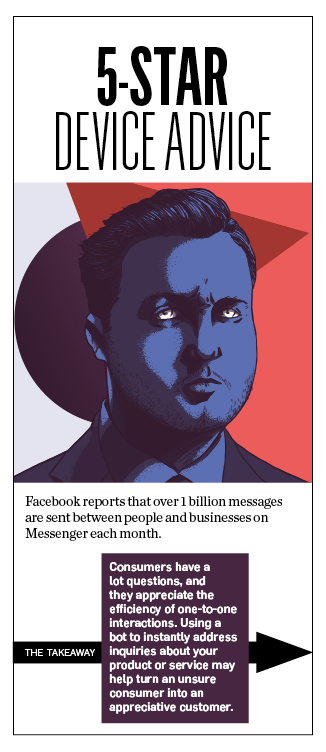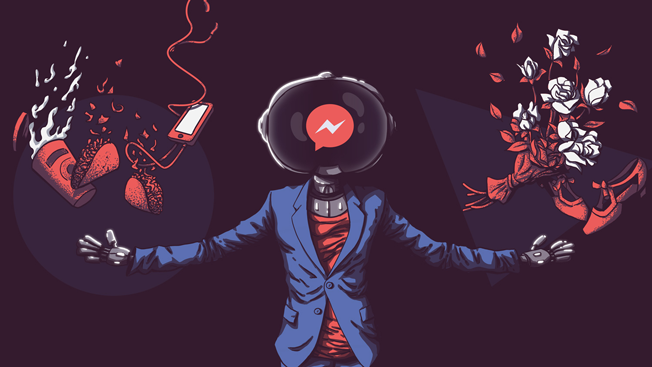At F8, Facebook’s annual developer conference last month, the company demonstrated how customers can interact with a chatbot on Messenger, the social network’s stand-alone messaging app. “To order from 1-800-FLOWERS, you never have to call 1-800-FLOWERS again,” Facebook told the crowded auditorium. The company then showed how to send a bouquet by simply messaging a bot.
Because bots can mimic human interaction and anticipate user interest, brands view this hot new tech as a way of having real-time conversations with consumers and securing a more direct path to purchase. To that end, Facebook is making Messenger into an open platform so brands can harness the power of artificial intelligence via chatbots. “We think that you should just message a business in the same way you would message a friend,” the company said.
 This could be why 2016 is already turning into the year of the bot. In March, Microsoft unveiled Tay—a virtual friend for millennials—on messaging apps Kik, GroupMe and Twitter. And Slack, which has rapidly become the go-to workplace messaging system, has been ramping up its popular Slackbot system over the past year as well. Last year the company announced an $80 million fund to invest in companies that integrate with its software.
This could be why 2016 is already turning into the year of the bot. In March, Microsoft unveiled Tay—a virtual friend for millennials—on messaging apps Kik, GroupMe and Twitter. And Slack, which has rapidly become the go-to workplace messaging system, has been ramping up its popular Slackbot system over the past year as well. Last year the company announced an $80 million fund to invest in companies that integrate with its software.
Brands are flocking to bots
Brands are already honing their bot strategies. Uber and Facebook partnered last fall to let users hail rides on Messenger instead of through the rideshare startup’s own app. And Fandango recently announced that it will be one of the first entertainment businesses to launch a chatbot for Messenger to help moviegoers discover films and purchase tickets.
Meanwhile, at the NewFronts AwesomenessTV debuted “AwesomenessTV bot,” which lets fans chat with the network on Kik and includes native video with clips featuring stars from its shows. In the future, AwesomenessTV plans to create bots based on characters to share behind-the-scenes features and even alternative endings.
Fast food brands are finding ways to utilize chatbots, too. In April, Taco Bell introduced the TacoBot, an AI-powered way to order fast food Tex-Mex through Slack. Users simply type in a menu item and pay through TacoBot, then pick it up at the closest Taco Bell. This highlights one of the most compelling features of chatbots: Accessibility.
Making products more accessible is what is largely driving this trend
The app rush of just a few years ago, where every brand was eager to create its own mobile platform, stalled as consumers began to crave ease and simplicity. It turns out that people don’t actually want to download and learn a myriad of apps, or have to find different websites every time they want to order a snack or buy an airline ticket. “Messengers are the new browser and bots are the new websites,” Mike Roberts, head of messenger services at Kik, told Adweek.
China’s massively popular mobile app WeChat has been the talk of Silicon Valley for the past year. WeChat is about as convenient as it gets—users can book a doctor appointment, purchase diapers, order food, etc. via text messages. WeChat takes a slice for using its services, and its average revenue per user is an incredible $7.
Opening up Messenger’s bot platform to brands will make for a better experience for customers, according to the social media giant. It also hints at something a lot more like WeChat. After all, if people don’t want to download yet another app or learn a new interface, Facebook might be the only network large enough—it has over 900 million people who use Messenger each month—to stitch together the consumer’s fractured online experience on a chat platform using bots.
On one hand, Facebook already owns a huge piece of the pie, and the prospect of further dominance via bots will likely make some people nervous. That said, most see the promise of bots in much broader terms. “Every major messenger is in [the chatbot space], and I can’t remember the last time we’ve all made a bet together,” said Roberts. “It’s only going to drive more interest.”
Eventually, most online consumer behavior, from making a hotel reservation to exchanging a sweater, will mean interacting with a bot. The more interaction that occurs, the better the bot will adapt to the consumer. And the more the consumer will come to rely on it.









